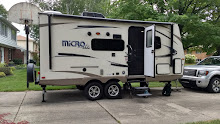Sat.
Apr. 1: After a full buffet breakfast at the hotel we boarded our bus with
driver, Nate, who would be with us in New Orleans and part of the way up the
Mississippi. On board we met our local expert tour guide, the very dynamic Ann,
who gave a rapid fire and continuous commentary for an overview of the city of
New Orleans. We began with a drive through the Ninth Ward where devastation
from Hurricane Katrina (August 29, 2005) is still apparent. While the rest of
the city has largely recovered, the Ninth Ward is a different story.
 |
Ann took this picture of Marv and me "hanging off the streetcar" in the
dining room of the hotel at breakfast our first morning. |
 |
| Along Canal Street from the bus. |
 |
New Ninth Ward houses are raised and often have solar panels but
the new ones are few and far between. The population of the Ninth Ward
is greatly diminished and many people will probably never return. |
 |
One of the many canals that overflowed during Hurricane Katrina from
the massive storm surge on Lake Ponchartrain. |
From there
we drove through areas along Lake Pontchartrain, Bayou St. John, one of the
famed and mysterious above-ground cemeteries where the departed are interred
and City Park with its magnificent oak trees. We were supposed to take a
self-guided walk through the sculpture garden there but found that there was a
big fundraiser going on for the Museum of Modern Art, making most of the museum
grounds inaccessible without a ticket. Instead we had time to walk the grounds of City Park a bit before we drove to New Orleans Superior Seafood for lunch.
 |
Saint Louis Cemetery #3. We learned how the bones of the dearly departed over time were
pushed to the back of and off a raised pallet to allow a new family member to be interred. |
 |
Perpetual Care agreements keep some of the tombs in pristine condition. When a family
dies out and no longer uses the tomb, an exhaustive search is made to be sure there are no
survivors who will want to be buried there. Then an elite member of a Creole caste ceremoniously
clears and reburies all the remains and the tomb can be resold to a new family to use. |
 |
| Shelby, Ann, Peggy, Mary & Chuck under an old Live Oak at City Park |
 |
| A contented turtle basks in the sun in a pond at City Park |
After
lunch we took a walking field trip in the Garden District (named in the British
style of calling a yard a garden, not for the gardens in the sense of flowers
or vegetables). Ann does architectural tours as well as general city tours so
she had a wealth of knowledge about the styles used in the graceful mansions. One
of the loveliest neighborhoods in the country, it was laid out in 1832 for
incoming, well-to-do Americans who were not interested in mingling with native
New Orleanians (The feeling was mutual!) Grand houses were built on large lots
that encouraged the development of beautiful yards. We saw the three houses once
owned by author Ann Rice, including the house where our sister-in-law Janis
Long had her wedding shower 30 years ago (before Ann Rice bought it) that included family friends Cokie
Roberts and Lindy Boggs.
 |
| An original, open-car street car on Saint Charles Street |
 |
| Some of the magnificent wrought iron work in the Garden District |
Dinner
that evening was on our own so the three of us went to Chartre House in the
French Quarter for some authentic New Orleans food. Afterwards we went to two jazz
clubs on Bourbon Street—Fritzel’s and Maison Bourbon—for Dixieland Jazz. It was
nearly 11:00 when we walked back to the Holiday Inn and fell gratefully into
bed.
 |
| St. Louis Cathedral on Jackson Square in the evening |
 |
| Bourbon Street |
 |
| Fritzel's Jazz Club |
 |
| Maison Bourbon Jazz Club |
 |
| Bourbon Street after dark |






















No comments:
Post a Comment